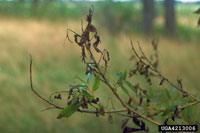Venturia saliciperda and Glomerella miyabeana
Hosts
Willow
Distribution and Disease Cycle

Photo credit: Mary Ann Hansen, Virginia Polythechnic Institute and State University, Bugwood.org
Willow scab and black canker of willow, caused by two different fungal pathogens are often present simultaneously and collectively called willow blight. Scab is caused by Venturia saliciperda, while black canker is caused by Glomerella miyabeana. Both diseases can cause defoliation, branch dieback and even tree death in severe infections. The fungus causing willow scab overwinters on dead twigs, releasing spores in spring to infect newly developing shoots. Disease development is favoured by wet weather in spring. The fungus that causes black canker also overwinters on dead twigs but disease development typically does not occur until later in the season, resulting in cankers forming on larger, older stems than those typically infected by willow scab.
Symptoms and Signs

Photo credit: Minnesota Department of Natural Resources Archive, Minnesota Department of Natural Resources, Bugwood.org
Symptoms of both willow scab and black canker are similar. Infected leaves shrivel and droop as the disease infects the base of the leaf petiole and stem, forming dark brown or black cankers. Infection by willow scab will result in olive brown spore masses forming on dead leaves and petioles. In contrast, black canker infections result in peach coloured spore masses produced on stem cankers.
Control
Prune and destroy diseased branches during the dormant season to decrease the spread of these diseases. No chemicals are registered for control of either willow scab or black canker.